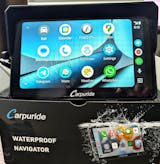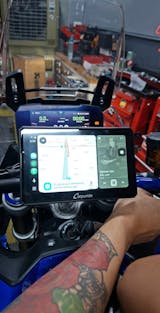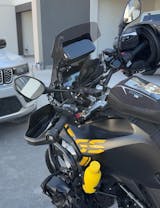Whether you're cruising city streets, tackling rough off-road terrain, or hitting the track, having the correct pressure ensures optimal handling, fuel efficiency, and tire longevity. Read this guide and understand how to manage your tire pressure effectively.
Recommended Tire Pressure for Different Motorcycles
The ideal tire pressure varies depending on the types of motorcycles you ride. While manufacturers provide guidelines, adjusting for your specific needs is key to maintaining a smooth and safe ride.
Street Motorcycles
These bikes typically require higher tire pressure to handle paved surfaces, and achieve balanced traction and responsive steering. Front tires usually range from 32-36 psi, while rear tires often range from 36-42 psi.
Off-Road Motorcycles
For dirt trails and rugged terrain, off-road bikes can grip uneven surfaces and run more stably with lower tire pressure. Front tires are often set between 12-15 psi, with rear tires around 10-14 psi.
Dual-Sport / Adventure Motorcycles
These bikes require separate tire pressure adjustments for on-road and off-road riding. For street riding, you’ll want a pressure closer to street bike levels (around 30-35 psi), while off-road settings may drop as low as 20 psi to improve traction.
Track Motorcycles
For track riding, tire pressure needs to be carefully managed to optimize grip and heat distribution. Typically, front tire pressure is set between 30-34 psi, while rear tire pressure is around 28-32 psi.

How to Know if the Tire Pressure is Right for You?
Finding the perfect tire pressure isn't just about following the manufacturer's guidelines—it’s about tailoring it to your riding style and conditions. Here are the tips for you:
-
Start by checking the pressure recommended in your motorcycle’s manual.
-
Feel the Ride. If your motorcycle feels sluggish or unresponsive, your tire pressure might be too low. Conversely, if the ride feels harsh or bumpy, you may be running too much air.
-
Check Tire Wear Patterns. Uneven wear, especially in the center of the tire, often signals over-inflation, while excessive wear on the outer edges can point to under-inflation.
-
Temperature and Altitude also affects the tire pressure. It rises in hot weather and drops in cold environments due to the expansion and contraction of air. At higher altitudes which have lower temperatures, pressure can also decrease. Adjust the tire pressure based on the environmental temperature.
Tire Pressure Adjustments for Different Riding Scenarios
Your motorcycle’s tire pressure needs to be fine-tuned based on the riding conditions. Here’s how you can adjust for different situations:
Riding with Passengers
When carrying a passenger, you should typically increase the tire pressure by 2-3 psi for both the front and rear tires. This helps maintain proper handling and prevents tire wear caused by the extra weight.
Carrying Gear
If you’re loaded with gear, particularly on the rear, increase the rear tire pressure by 3-5 psi. For larger loads, start with a smaller increase and test ride to feel how stable the bike is. If the rear feels too soft, continue adding pressure until it feels balanced.
Off-Road Riding
For off-road conditions, lower your tire pressure by 5-10 psi from the manufacturer’s recommendation. For most off-road motorcycles, this means bringing the front tire to around 12-15 psi and the rear tire to 10-14 psi. This helps improve traction. Be cautious not to go too low, as tires may become prone to punctures or pinch flats.
Riding in Rain
In wet conditions, maintain manufacturer-recommended pressure levels or lower. Slightly lower pressure (by 1-2 psi) can help increase the contact patch and improve grip on wet roads.
Highway Touring
For long-distance highway riding, you can keep tire pressure on the higher end of the recommended range (36-42 psi for rear tires). It reduces rolling resistance and improves fuel efficiency over long stretches. If you notice your bike drifting or feeling too stiff, slightly lower the rear tire pressure.
Cold Weather
In cold weather, tire pressure drops naturally, so you’ll need to add 1-2 psi to compensate. Make sure to check your tire pressure more frequently in colder months, as the air inside contracts and reduces the pressure.
Factors Affecting Motorcycle Tire Pressure
Rider Weight and Cargo
Heavier riders or extra gear increase the load on your tires, requiring slightly higher pressure to maintain stability and prevent tire damage.
Terrain
Street, off-road, and track surfaces demand different tire pressures. Smooth roads require higher pressure for efficiency, while rough terrain needs lower pressure for better traction.
Tire Type (Tubed vs. Tubeless)
Tubeless tires can handle lower pressures for improved grip, whereas tubed tires typically need more air to avoid pinch flats.
Temperature
Heat causes tire pressure to rise, so it’s essential to check pressure when the tires are cold and make adjustments for extreme weather conditions.
How to Check and Maintain Motorcycle Tire Pressure?
Maintaining proper tire pressure is simple with the right tools and techniques. Follow these steps to ensure your tires are always at their best:Tools to Use:
Digital Gauges: More precise and easier to read, but often need batteries.Mechanical Gauges: Reliable and simple, no batteries required, but can be harder to read.
Step-by-Step Guide:
-
Check your tire pressure when the tires are cold, as riding heats them up and can give inaccurate readings.
-
Use a tire gauge to measure pressure—digital or mechanical both work well.
-
Compare the reading to the manufacturer's recommendation, found in your bike’s manual or on the tire sidewall.
-
If the pressure is too low, inflate the tires using an air compressor. If it's too high, release air gradually.
Adjusting Tire Pressure:
Inflate or deflate your tires in small increments. Check the pressure again after each adjustment to make sure it's within the recommended range. Proper pressure ensures optimal grip, stability, and tire longevity.
When and How Often to Check Tire Pressure
Regularly checking your tire pressure is crucial for maintaining performance and safety. Here’s when and how often you should be doing it:
Before Every Ride
Ideally, check your tire pressure before every ride, especially if you’re planning a long trip or riding in varying conditions like off-road or in the rain.
At Least Once a Week
For regular, short-distance rides, checking your tire pressure once a week is a good habit. Even if your bike hasn’t moved, pressure can decrease over time, especially during temperature changes.
After Major Temperature Swings
Sudden changes in temperature, like transitioning from summer to winter, can cause a significant drop in tire pressure. It’s wise to check your tires more frequently during these times.
The Risks of Incorrect Tire Pressure
Riding with incorrect tire pressure can lead to a range of problems, from poor handling to dangerous blowouts. Here are the key risks associated with both under-inflation and over-inflation:
Under-Inflation:
-
Causes increased tire wear, particularly on the outer edges.
-
Reduces fuel efficiency as the tires create more rolling resistance.
-
Affects handling, making your bike feel sluggish and less responsive, especially in corners.
-
Puts the tire at risk of overheating, which can lead to a blowout.
Over-Inflation:
-
Reduces the tire’s contact patch with the road, which compromises traction, especially on wet surfaces.
-
Causes uneven wear, particularly in the center of the tire, shortening the tire’s lifespan.
-
Makes the ride feel harsher and less comfortable, as the tire can’t absorb road bumps effectively.
-
Increases the risk of a puncture or tire damage from road debris.

Additional Tips for Safe Riding
Incorporating these motorcycle safety tips, along with using devices like a portable CarPlay screen, will ensure your motorcycle is always ready for a safe, controlled ride.
Inspect Tires Regularly
Check for visible signs of wear, cracks, or punctures. Worn-out tires, even with the correct pressure, can still be dangerous on the road.
Check Tire Alignment
Misaligned wheels can cause uneven tire wear and affect handling. Periodically checking alignment ensures your tires wear evenly and your bike stays stable.
Monitor Tread Depth
Tires with worn tread lose traction, especially in wet conditions. Replace them once the tread depth falls below the recommended level, typically 1/16 of an inch.
Use Waterproof CarPlay Screen for Motorcycle
Adding a motorcycle CarPlay system boosts your focus on the road. With apple CarPlay for motorcycles, you can access navigation, music, and calls hands-free, ensuring your attention stays where it matters most. Plus, if you're involved in a traffic accident and your phone is safely stored in your pocket, a waterproof touch screen motorcycle radio with wireless CarPlay for motorcycle will allow you to quickly make a call for help, without risking your phone.
Don’t Forget About the Valve Caps
Valve caps help keep dirt and moisture out of the valve stem, preventing leaks. Make sure they’re screwed on securely after every check.
Conclusion
Maintaining the correct tire pressure and following key safety tips ensures your motorcycle performs at its best, providing a smoother and safer ride. For even more security and convenience, consider upgrading with Carpuride’s motorcycle CarPlay with CarPlay, allowing you to stay connected and focused on the road. Enhance your riding experience today with a portable CarPlay system from Carpuride.
Read More:
How to install a stereo on a motorcycle?
Best 8 MotorCycle Audio System in 2024















